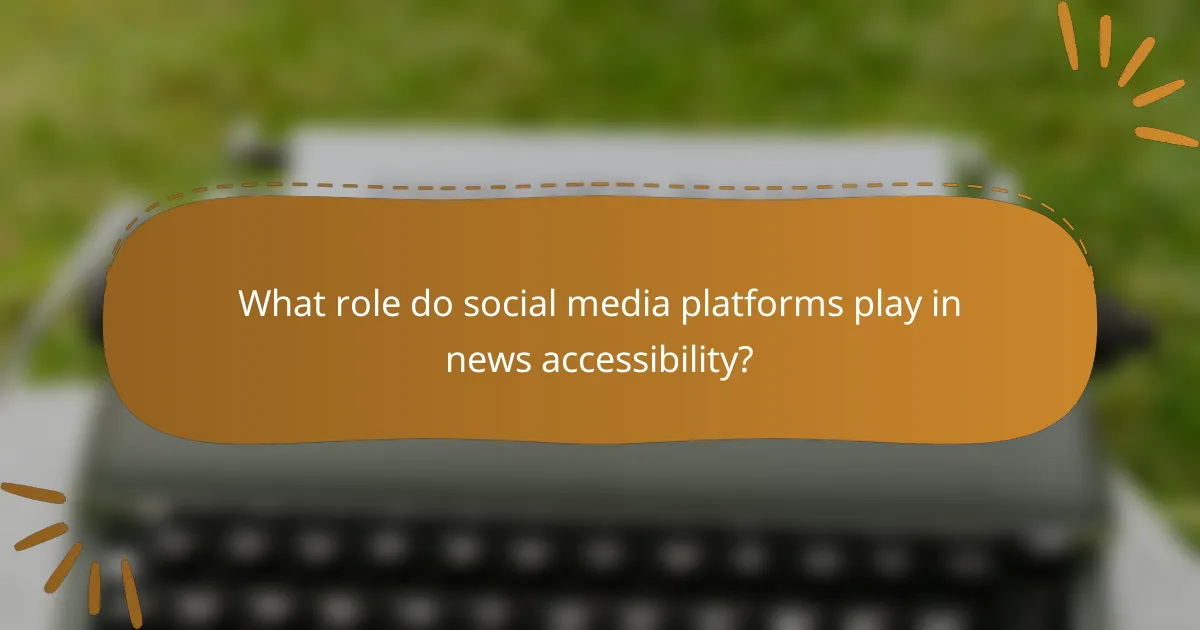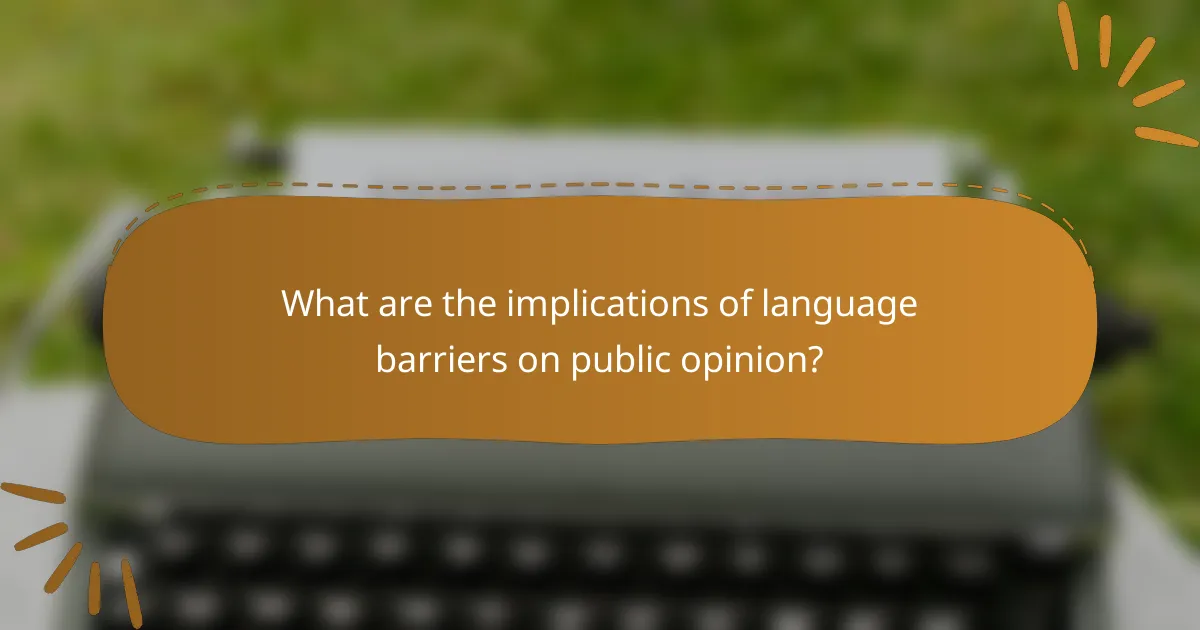Language barriers pose a significant challenge to news accessibility for non-English speakers, hindering their ability to comprehend and engage with critical information. This limitation not only contributes to misinformation but also diminishes their awareness of essential local and global events, impacting their overall participation in society. Addressing these barriers through solutions like automated translation tools and multilingual news platforms is crucial for fostering inclusivity in media narratives.

How do language barriers affect news accessibility for non-English speakers?
Language barriers significantly limit news accessibility for non-English speakers by restricting their ability to understand and engage with information. This can lead to a lack of awareness about important local and global events, ultimately affecting their participation in society.
Limited access to information
Non-English speakers often struggle to find news sources that provide content in their native languages, resulting in limited access to crucial information. Many mainstream news outlets primarily publish in English, which can alienate large segments of the population who are not proficient in the language.
In regions with diverse linguistic communities, such as the European Union, the lack of multilingual news platforms can exacerbate this issue. For instance, a Bulgarian speaker may have difficulty accessing news that is readily available in English or German, leading to gaps in knowledge about local and international affairs.
Reduced engagement with global events
Language barriers can lead to reduced engagement with global events, as non-English speakers may miss out on critical discussions and analyses that shape public opinion. When news is not accessible, individuals may feel disconnected from the broader world, limiting their ability to participate in civic activities.
For example, during major international events like climate summits or political elections, non-English speakers may not receive timely updates or diverse perspectives, which can hinder informed decision-making. This disengagement can perpetuate social divides and diminish the overall inclusivity of public discourse.

What are the main challenges faced by non-English speakers in accessing news?
Non-English speakers encounter significant barriers when trying to access news, primarily due to language limitations. These challenges can lead to misinformation, reduced awareness of current events, and a lack of representation in media narratives.
Inadequate translation services
Many news outlets lack effective translation services, which can result in poorly translated content that misrepresents the original message. This inadequacy often stems from the reliance on automated translation tools that may not capture nuances or context.
Additionally, professional human translators are often in short supply, particularly for less common languages. This shortage can lead to delays in news dissemination, leaving non-English speakers without timely information.
Lack of multilingual news platforms
There is a notable scarcity of news platforms that offer content in multiple languages, limiting access for non-English speakers. Most mainstream media outlets primarily publish in English, which can alienate significant portions of the population.
Some platforms do exist, but they may not cover a broad range of topics or provide comprehensive reporting. Non-English speakers often have to rely on smaller, community-based outlets that may not have the same resources or reach as larger organizations.

What solutions exist to improve news accessibility?
Several solutions can enhance news accessibility for non-English speakers, including automated translation tools and the development of multilingual news websites. These approaches aim to bridge the language gap, making news content more inclusive and widely available.
Use of automated translation tools
Automated translation tools, such as Google Translate and DeepL, can quickly convert news articles into various languages. These tools utilize advanced algorithms to provide translations, but the accuracy can vary significantly based on the complexity of the text and the languages involved.
While these tools are convenient, they may not always capture nuances or cultural references accurately. Users should verify translations, especially for critical news, to ensure they understand the context correctly. It’s advisable to use these tools as a starting point rather than a definitive source.
Development of multilingual news websites
Creating multilingual news websites allows publishers to offer content in multiple languages directly. This approach ensures that non-English speakers receive accurate translations tailored to their cultural context, enhancing comprehension and engagement.
When developing such websites, it’s essential to consider user experience and navigation. Providing language options prominently and ensuring that the layout remains consistent across translations can improve accessibility. Additionally, incorporating local news alongside international coverage can further engage diverse audiences.

How can media organizations address language barriers?
Media organizations can effectively address language barriers by adopting inclusive practices that ensure news is accessible to non-English speakers. This involves creating editorial policies that prioritize multilingual content and collaborating with language experts to enhance translation accuracy and cultural relevance.
Implementing inclusive editorial policies
Inclusive editorial policies are essential for making news accessible to diverse audiences. Media organizations should establish guidelines that mandate the translation of key articles into multiple languages, ensuring that critical information reaches non-English speaking communities. This can include prioritizing languages spoken by significant local populations.
Additionally, organizations can adopt a framework for evaluating the effectiveness of their multilingual content. Regular feedback from non-English speakers can help refine these policies, ensuring they meet the needs of the audience. For instance, surveys or focus groups can provide insights into which languages and topics are most relevant.
Collaborating with local language experts
Collaborating with local language experts is crucial for producing accurate and culturally sensitive translations. Media organizations should seek partnerships with translators who are not only fluent in the target language but also familiar with local dialects and cultural nuances. This ensures that the news resonates with the intended audience.
Furthermore, organizations can benefit from establishing a network of community liaisons who can provide ongoing insights into language preferences and emerging issues within non-English speaking communities. This proactive approach helps maintain relevance and fosters trust between the media and its diverse audience.

What role do social media platforms play in news accessibility?
Social media platforms significantly enhance news accessibility for non-English speakers by enabling the sharing of content across diverse languages. They facilitate connections between users and news sources, allowing for a broader dissemination of information tailored to various linguistic communities.
Facilitating content sharing in multiple languages
Social media allows users to share news articles and updates in multiple languages, making it easier for non-English speakers to access important information. Platforms like Facebook and Twitter often feature translation tools that automatically convert posts into the user’s preferred language, increasing the reach of news content.
Users can also share links to articles in their native language, which can help others in their network stay informed. This organic sharing process often leads to a more diverse audience for news outlets, promoting inclusivity in information dissemination.
Providing language-specific news feeds
Many social media platforms offer options for users to customize their news feeds based on language preferences. This feature allows non-English speakers to follow news sources that publish content in their native language, ensuring they receive relevant updates without language barriers.
For example, platforms like Instagram and TikTok allow users to follow accounts that focus on specific languages or regions, providing a tailored news experience. Users should take advantage of these features to curate their feeds, ensuring they stay informed about local and global events in a language they understand.

What are the implications of language barriers on public opinion?
Language barriers significantly distort public opinion by limiting access to information for non-English speakers. This can lead to misunderstandings and a lack of awareness about global issues, ultimately shaping perceptions in a skewed manner.
Skewed perceptions of global issues
Language barriers can create a narrow view of international events, as non-English speakers may rely on translated news that lacks context or depth. This often results in a fragmented understanding of critical issues, such as climate change or geopolitical conflicts, which are reported differently across languages.
For example, a non-English speaker might miss out on nuanced discussions or local perspectives that are prevalent in English-language media. This can lead to a misinformed public that is unaware of the full scope of global challenges.
Impact on democratic participation
Language barriers hinder democratic participation by disenfranchising non-English speakers from engaging in political discourse. When important information about policies, elections, and civic duties is primarily available in English, it limits the ability of these individuals to make informed decisions.
Moreover, non-English speakers may struggle to access voting materials or understand candidates’ platforms, which can decrease voter turnout. Ensuring multilingual resources and support can help bridge this gap and promote more inclusive democratic processes.

How can technology enhance news accessibility for non-English speakers?
Technology can significantly improve news accessibility for non-English speakers by providing real-time translation and localization services. These advancements help bridge language gaps, allowing diverse audiences to access crucial information in their preferred languages.
AI-driven translation advancements
AI-driven translation tools utilize machine learning algorithms to enhance the accuracy and speed of translations. These systems can analyze vast amounts of text data, learning from context to produce more natural-sounding translations that are crucial for news articles.
For example, platforms like Google Translate and DeepL have made strides in offering translations that are not only quick but also contextually relevant. Users can expect translations that capture the nuances of language, which is essential for understanding complex news topics.
However, while AI translations are improving, they may still struggle with idiomatic expressions or specialized terminology. It’s advisable for news organizations to combine AI tools with human oversight to ensure that critical information is conveyed accurately and effectively.
